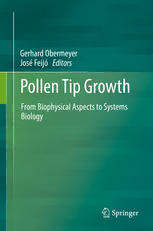
Pollen Tip Growth: From Biophysical Aspects to Systems Biology PDF
Preview Pollen Tip Growth: From Biophysical Aspects to Systems Biology
Gerhard Obermeyer José Feijó Editors Pollen Tip Growth From Biophysical Aspects to Systems Biology Pollen Tip Growth Gerhard Obermeyer • José Feijó Editors Pollen Tip Growth From Biophysical Aspects to Systems Biology 123 Editors GerhardObermeyer JoséFeijó DepartmentofMolecularBiology CellBiologyMolecularGenetics UniversityofSalzburg UniversityofMaryland Salzburg,Austria CollegePark Maryland,USA ISBN978-3-319-56644-3 ISBN978-3-319-56645-0 (eBook) DOI10.1007/978-3-319-56645-0 LibraryofCongressControlNumber:2017942819 ©SpringerInternationalPublishingAG2017 Thisworkissubjecttocopyright.AllrightsarereservedbythePublisher,whetherthewholeorpartof thematerialisconcerned,specificallytherightsoftranslation,reprinting,reuseofillustrations,recitation, broadcasting,reproductiononmicrofilmsorinanyotherphysicalway,andtransmissionorinformation storageandretrieval,electronicadaptation,computersoftware,orbysimilarordissimilarmethodology nowknownorhereafterdeveloped. Theuseofgeneraldescriptivenames,registerednames,trademarks,servicemarks,etc.inthispublication doesnotimply,evenintheabsenceofaspecificstatement,thatsuchnamesareexemptfromtherelevant protectivelawsandregulationsandthereforefreeforgeneraluse. Thepublisher,theauthorsandtheeditorsaresafetoassumethattheadviceandinformationinthisbook arebelievedtobetrueandaccurateatthedateofpublication.Neitherthepublishernortheauthorsor theeditorsgiveawarranty,expressorimplied,withrespecttothematerialcontainedhereinorforany errorsoromissionsthatmayhavebeenmade.Thepublisherremainsneutralwithregardtojurisdictional claimsinpublishedmapsandinstitutionalaffiliations. Printedonacid-freepaper ThisSpringerimprintispublishedbySpringerNature TheregisteredcompanyisSpringerInternationalPublishingAG Theregisteredcompanyaddressis:Gewerbestrasse11,6330Cham,Switzerland Contents PartI Introduction 1 PollenTubesandTipGrowth:ofBiophysicsandTipomics ........... 3 GerhardObermeyerandJoséFeijó PartII BiophysicsofTipGrowth 2 WaterTransportinPollen................................................. 13 GerhardObermeyer 3 The CytoskeletonofPollenTubes andHowIt Determines thePhysico-mechanicalPropertiesofCellWall......................... 35 GiampieroCai,LuigiParrotta,andMauroCresti PartIII TechnicalImprovementstoStudyTipGrowth 4 MeasuringCytomechanicalForcesonGrowingPollenTubes......... 65 Hannes Vogler, Naveen Shamsudhin, Bradley J. Nelson, andUeliGrossniklaus 5 Microfluidic- and Microelectromechanical System (MEMS)-BasedPlatformsforExperimentalAnalysisofPollen TubeGrowthBehaviorandQuantificationofCellMechanical Properties.................................................................... 87 AnjaGeitmann PartIV SubcellularProcesses 6 PolarProteinExocytosis:LessonsfromPlantPollenTube............ 107 HaoWangandLiwenJiang 7 Pollen Tip Growth: Controlof Cellular Morphogenesis ThroughIntracellularTrafficking ....................................... 129 HanaRakusováandAnjaGeitmann v vi Contents 8 DirectionalGrowthforSpermDelivery.................................. 149 SubramanianSankaranarayananandTetsuyaHigashiyama 9 MolecularMechanismsRegulatingRootHairTipGrowth: AComparisonwithPollenTubes......................................... 167 SébastjenSchoenaers,DariaBalcerowicz,andKrisVissenberg PartV Tipomics:OmicApproachesinTipGrowth 10 WhenSimpleMeetsComplex:Pollenandthe-Omics ................. 247 Jan Fíla, Lenka Záveská Drábková, Antónia Gibalová, andDavidHonys 11 ThePollenMembraneProteome.......................................... 293 HeidiPertl-Obermeyer 12 Pollen MetabolomeDynamics: Biochemistry, Regulation andAnalysis................................................................. 319 ThomasNägele,LenaFragner,PalakChaturvedi,ArindamGhatak, andWolframWeckwerth PartVI ModelingTipGrowth 13 DerivationandUseofMathematicalModelsinSystemsBiology..... 339 RobertW.SmithandChristianFleck 14 A Fresh Look at Growth Oscillations in Pollen Tubes: KinematicandMechanisticDescriptions................................ 369 Milenka Van Hemelryck, Roberto Bernal, Enrique Rojas, JacquesDumais,andJensH.Kroeger 15 OneThousandandOneOscillatorsatthePollenTube Tip: TheQuestforaCentralPacemakerRevisited .......................... 391 DanielS.C.Damineli,MariaTeresaPortes,andJoséA.Feijó Index............................................................................... 415 Editors’ Biographies Gerhard Obermeyer born in 1961, studied biology at the University of Konstanz, Ger- many, with majors in mem- brane and cell biophysics. His Ph.D. thesis at the Karlsruhe Institute of Technology (Ger- many) included the imaging of tip-localized Ca2C gradients in pollen tubes and first patch- clamp experiments to character- ize pollen ion channels. As a postdoc,he worked at Wye Col- lege (now part of Imperial Col- lege,London,UK)onionchannelsfromguardcellsandpollengrainsandcontinued pollenresearchattheInstituteofPlantPhysiology(UniversityofSalzburg,Austria) with intermediate fellowships to visit labs at the University of Adelaide (South Australia), in Cuernavaca (Mexico),and in Oxford (UK) to work on symbiosome membranes and intracellular pH measurements. Finally, he became an associate professor at the University of Salzburg where he established molecular plant physiologyinresearchandteaching. Prof.Obermeyer’sresearchfocusesmainlyonpollenphysiology.Thegrowthof pollen tubes through the style tissue is a prerequisite for a successful fertilization whichguaranteeshighcropyieldsforhumannutrition.Problemscausedbyglobal warming like drought and temperature stress, can disturb pollen function and are studiedusingseveralsingle-molecule/single-celltechniquesin combinationwith - omicsapproachesto revealfunctionalproteincomplexesin the plasmamembrane andtheirroleinosmosensingandosmoregulationaswellasintipgrowth. vii viii Editors’Biographies JoséFeijóstudiedbiologyatthe University of Lisbon, Portugal, specializing in cell biology of orchid pollen, and obtained his master’s in plant biotechnology. DuringhisPh.D.heenlargedhis focusintodevelopment,progres- sively introducing electrophys- iology and mathematical mod- elling as routine approaches to thestudyofpollentubes.AFul- brightfellowshipbroughthimto PeterHepler’slabattheUniversityofMassachusettsinAmhersttofurtherdeepen his skills on ion imaging. His return to the University of Lisbon in 1996 marked the beginningof his professorshipand independentresearch career; from 1999 to 2013, he ran in parallel with an independent lab at the Gulbenkian Institute for Science.Alongthispath,hehasservedasadirectoroftheImagingUnit,organized over a dozen EMBO practical courses on plant development and imaging, acted as a curator, and collaborated with numerous educational projects; he was also responsible for a number of initiatives to commemorate Darwin’s bicentenary in 2009.Inlate2013,hemovedtotheUniversityofMaryland,CollegePark,andlives inWashington,DC. TheresearchofFeijó’sgroupisfocusedonthedevelopmentofintegratedmodels of apical cell growth and morphogenesis, using the pollen tube as a biological model,iondynamicsasanexperimentalparadigm,andtheoreticalmodelingasan integrative tool. The group uses Arabidopsis, lily, tobacco, and tomato as model speciesforhigherplantsandthemossPhyscomitrellaasanevolutionarycorrelate ofapicalgrowthevolution.Onthepathtodevelopmodelsbywhichiondynamics choreographiesintegrate spatial and temporal cues to coordinate cell biology, the groupcontributedtonovelionchannelsandsensorsinvolvedinpollentubebiology and their regulation mechanisms. Most results involve a combination of imaging, electrophysiology,genetics,andmolecularbiology.Feijó’sgroupfurtherpioneered transcriptomicsofplantmalegametesanditsconsequencesforplantreproduction andimprovement,namely,atthe epigeneticslevel.Theseactivitieswere routinely groundedincollaborationswithgroupsinover12countriesinthe4continents. TheauthorsmetattheSexualPlantReproductionmeetinginVienna,Austria,in 1998,andcollaborated;theybecamegoodfriendseversince. Part I Introduction Chapter 1 Pollen Tubes and Tip Growth: of Biophysics and Tipomics GerhardObermeyerandJoséFeijó Keywords Biophysics (cid:129) Molecular mechanisms (cid:129) Omics techniques (cid:129) Pollen (cid:129) Systemspollenbiology (cid:129) Tipgrowth (cid:129) Tipomics 1.1 Introduction Pollenisthemalegametophyteofhigherplantsandisresponsibleforthesuccessful transportofthespermcellsto theovules.Afterlandingona stigma,pollengrains willgerminateandgrowapollentubethroughthestigmaandstyle tissue towards the ovules,wherefertilizationtakesplace. In termsofcell biology,the elongation of the pollen tube is characterized by a dramatically polarized growth process, tip growth, which is common to root hairs, fungal hyphae and some developing neurites. Due to their simple morphology and function, growing pollen tubes becamethemostwell-establishedmodelsystemtostudytipgrowth.Boththeeditors ofthisbookhavebeenenthusiasticpaladinsofthistrend,evensincetheyfirstmet in 1994 during the 13th International Congress on Sexual Plant Reproduction in Vienna. Our intellectual enthusiasm was first materialized in an essay in which a naive and simple yet forward theoretical model was set forth, implying a set of electrochemistryrulestobeatthecoreofaminimalsetofmechanismunderlying cellpolarityestablishmentandmaintenanceduringpollentubegrowth(Feijóetal. 1995). In short, subcellular biophysical processes, like ion transport, endogenous electrical fields and a tip-focussed Ca2C gradient, would regulate the shape and growthrateinanessentiallyself-organizingprocess.Eversincethen,themultitude of nuts and bolts and genes and pathwaysand their biologicalconsequenceshave amounted to a vast literature in practically every aspect of the biology of pollen. G.Obermeyer((cid:2)) MolecularPlantBiophysicsandBiochemistry,DepartmentofMolecularBiology,Universityof Salzburg,Billrothstrasse11,5020Salzburg,Austria e-mail:[email protected] J.Feijó DepartmentofCellBiologyandMolecularGenetics,UniversityofMaryland,Bioscience ResearchBuilding,CollegePark,MD20742,USA e-mail:[email protected] ©SpringerInternationalPublishingAG2017 3 G.Obermeyer,J.Feijó(eds.),PollenTipGrowth, DOI10.1007/978-3-319-56645-0_1
